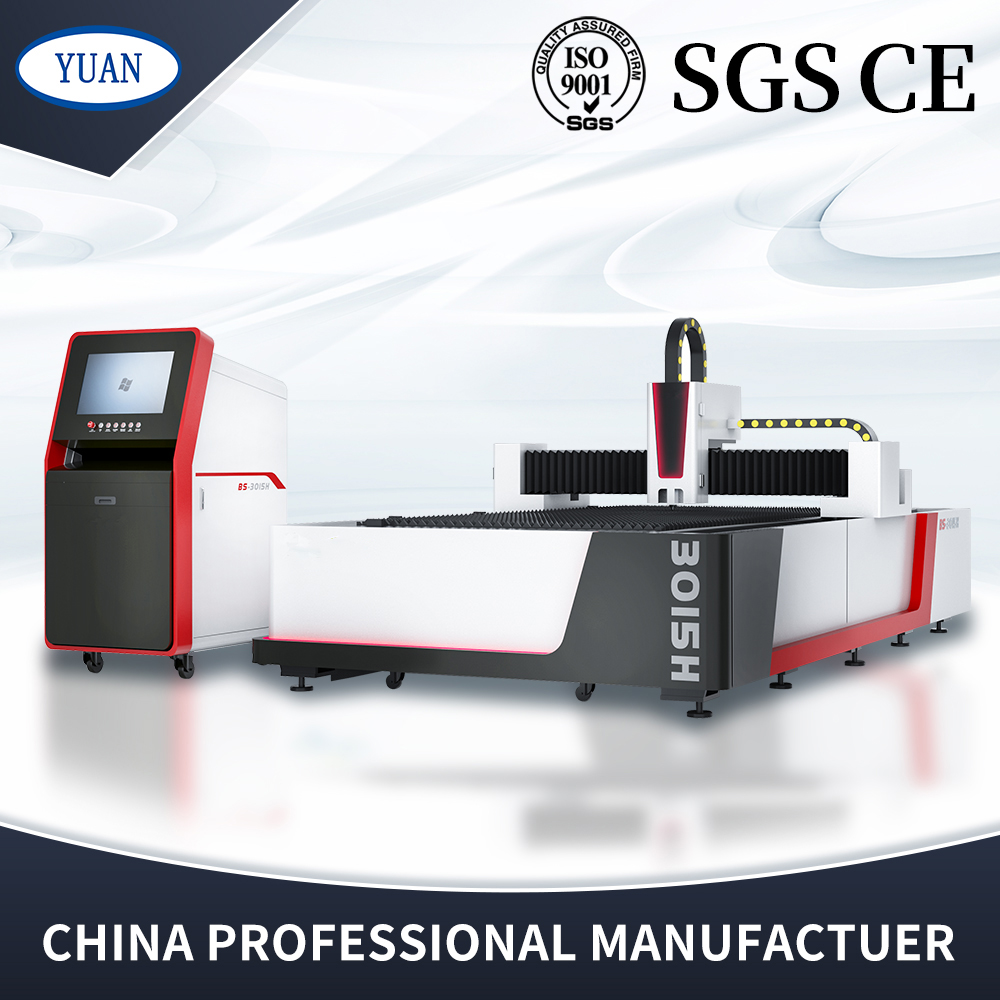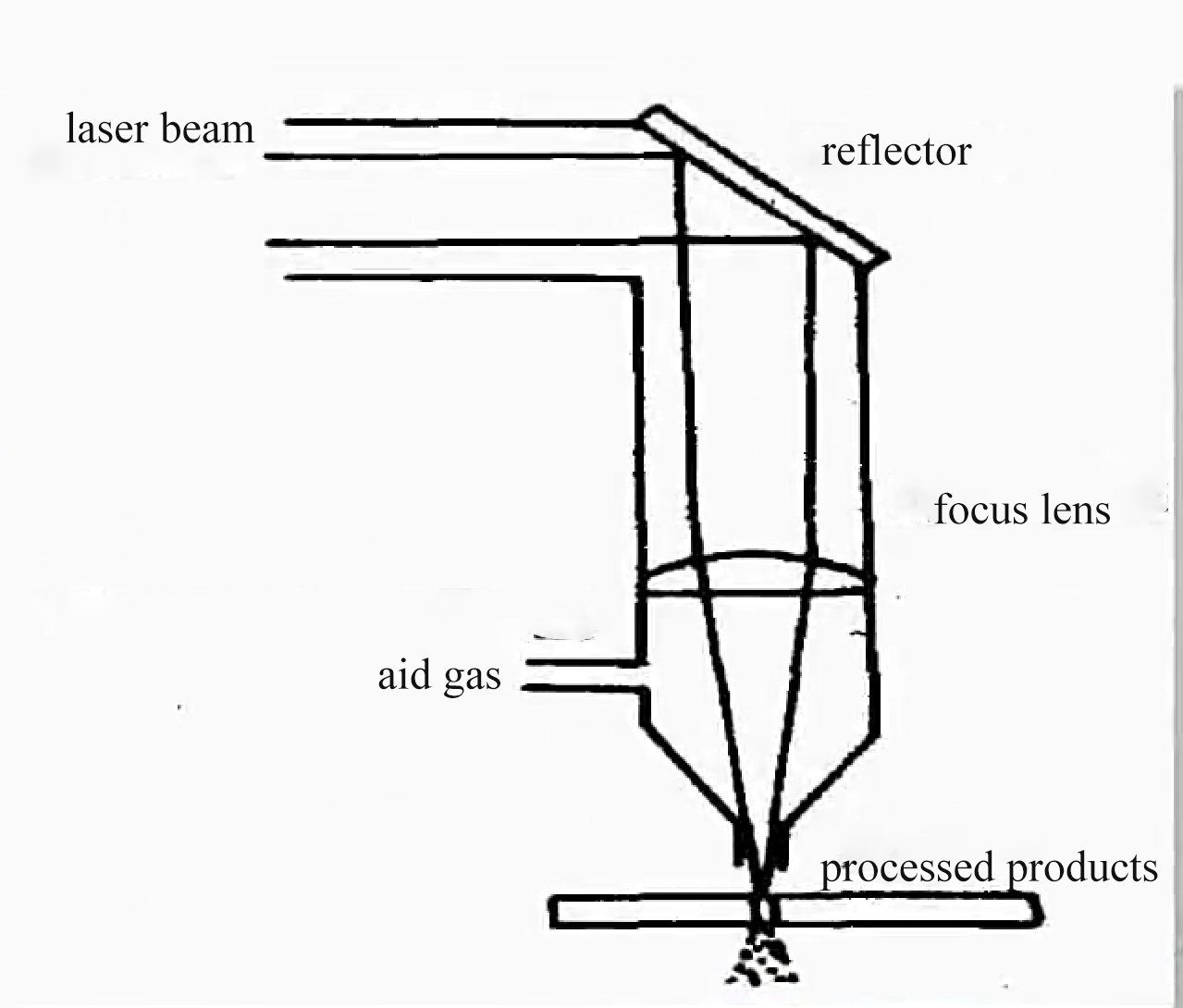Laser cutting is the most mature and widely used application technology in the laser processing industry.

Laser cutting uses a high-energy-density laser beam to melt or vaporize materials, and uses auxiliary gas to blow away the melted materials to form a cutting process.

The workpiece is heated by the laser beam and rises to a temperature above the boiling point. Part of the material turns into steam and escapes, and part of it is blown away from the bottom of the cutting slit as ejection material. The energy required is high and is suitable for materials that cannot be melted.
When the power density of the laser beam exceeds a certain value, it will evaporate inside the workpiece to form a hole. The auxiliary airflow coaxial with the beam will drive away the molten material around the hole and take it away. The required power density is about 1/10 of that of vaporization cutting.
By heating with a laser beam, brittle materials that are susceptible to thermal damage are cut off at high speed and in a controlled manner. The cutting mechanism can be summarized as follows: the laser beam heats a small area of brittle material, causing thermal gradients and subsequent severe mechanical deformation, causing the material to form cracks.
Oxygen or other reactive gases are used to replace the inert gas used for melting and cutting. Oxygen and metal undergo a violent combustion reaction, working together with the laser to form a small hole filled with vapor, and a slit is formed as the beam moves.
There are two heat sources when oxygen-assisted melting cutting by laser:
Laser irradiation energy and oxygen-metal exothermic reaction energy.
1. The heat affected zone at the edge of the cutting seam is small
2. The slit of laser cutting is narrow.
3. High cutting accuracy and small deformation of the workpiece
4. Good cutting repeatability and small error
5. The laser cutting surface is clean and free of slag.
6. Fast cutting speed and low noise
1. Laser cutting requires less total energy
2. The energy of laser cutting is highly concentrated
3. The laser focused spot diameter is small
4. CNC precision seaming
5. The physical metallurgical process of cutting is perfected
6. Suitable for the requirements of modern industry
Important process parameters for laser cutting:
Laser power, spot diameter, defocus amount, cutting speed, gas type, air flow, material type, material thickness, nozzle shape, nozzle aperture, nozzle distance.
Three main parameters:
Laser power
Material thickness
Cutting speed
Cutting roughness, kerf width, kerf taper, heat affected zone width, slag hanging degree, workpiece deformation, etc.
If the laser cutting speed is too low, the material will be over-burned, which will widen the slit and significantly increase the heat-affected area.
When the laser cutting speed is too high, the incision will not be cleaned cleanly and the incision will become rough.
1 Shape and size of cutting oxygen nozzle
2 Cutting Oxygen Pressure"
Cutting speed increases with pressure at low pressure
But when the pressure exceeds 0.3Mp, the cutting speed decreases instead.
Positive defocus: suitable for thin plates
Zero defocus: used for medium thickness plates
Negative defocus: suitable for thick plates
Laser cutting is a comprehensive technology integrating light, machinery and electricity.
Key technologies:
1. Focus position control technology
2. Cutting and perforation technology
3. Nozzle design and air flow control technology
Cutting and perforation technology: Any cutting technology, except for a few cases where you can start from the edge of the board, generally must punch a small hole in the board.
Cutting and perforation technology:
1 Blast perforation: The material is irradiated by continuous laser to form a pit in the center, and then the molten material is quickly removed by the oxygen flow coaxial with the laser beam to form a hole.
2 Pulse perforation: Use high peak power pulse laser to melt or vaporize a small amount of material. Air or nitrogen is often used as auxiliary gas to reduce the expansion of the hole due to exothermic oxygen. The gas pressure is smaller than the oxygen pressure during cutting. Each pulse of laser can only produce a small jet of particles that penetrates deeper gradually, so it takes a few seconds to pierce thick plates.
Cutting characteristics of different materials:
① Laser cutting of nickel alloy
It is similar to the cutting of stainless steel, but due to the higher viscosity of molten nickel, which is more likely to cause slag to adhere to the back of the slit, laser cutting of nickel-based alloys is generally completed under higher oxygen pressure. Depending on the alloy composition, the cutting speed is approximately 0.5-1.0 times that of cutting stainless steel of the same thickness.
②Laser cutting of titanium and titanium alloys
Since the oxidation reaction of titanium releases a large amount of heat, the oxidation reaction of titanium in oxygen-blown cutting is violent, the cutting speed is fast, and it is easy to cause overburning of the incision. Air is generally used as the auxiliary gas, which makes it easier to control the cutting quality. Blowing inert gas can reduce the problem of oxidative contamination, but there is a hot zone impact zone around the incision.
③Laser cutting of aluminum and aluminum alloys
Due to the high thermal conductivity of aluminum and its alloys and their high reflectivity to infrared lasers, it is difficult for continuous lasers to complete perforation. If the surface is polished to make it rough, coated with light-absorbing material or anodized aluminum surface, it can also be cut from the edge or from a pre-drilled hole.The most effective way to cut aluminum and its alloys is to use a pulsed laser with high repetition rate and high peak power.
④Laser cutting of copper materials:
Copper is similar to aluminum in that it has high reflectivity for infrared lasers and high thermal conductivity. It is difficult to perforate with continuous laser and is a difficult-to-cut material. Using pulsed laser with high repetition rate and high peak power to assist oxygen stimulation, copper alloy can be better cut.
⑤Laser cutting of organic materials
Pure organic materials have a large transmittance to YAG laser, so they are not suitable for YAG laser cutting, but they are suitable for CO2 laser cutting. It belongs to vaporization cutting, and the cutting quality is particularly good.
⑥Laser cutting of paper, wood, etc.:
Paper and wood do not melt. It is a vapor cutting. Chemical cracking occurs in the cutting area. The cracking products are blown away by the air flow, and the cut section is covered with residual carbon particles. Blowing air usually causes black burnt edges on the cutting seams. For thinner materials, CO2 laser cutting with low and medium power below 100W is commonly used.
For thicker materials, such as carton template cutting of multi-layer bakelite boards, 500-1500W CO2 laser cutting is commonly used. Through parameter control, wide and uniform rectangular slits can be cut.
⑦Laser cutting of glass and quartz
Glass materials have a high absorption rate of CO2 laser, so controlled fracture cutting is used for hair cutting. CO2 laser cutting of thin quartz plates or tubes is very efficient. For example, using a 450W CO2 laser to cut quartz light bulb tubes can cut 4,000 pieces per hour.